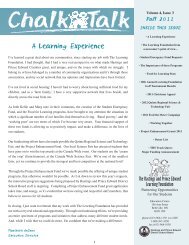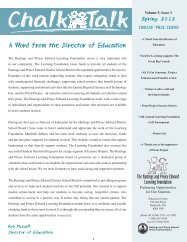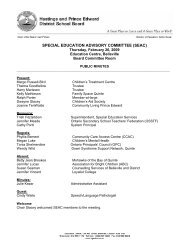Grade 11 Healthy Active Living Education Additional Supports ...
Grade 11 Healthy Active Living Education Additional Supports ...
Grade 11 Healthy Active Living Education Additional Supports ...
You also want an ePaper? Increase the reach of your titles
YUMPU automatically turns print PDFs into web optimized ePapers that Google loves.
Positive Mental Health and Stress<br />
Public Profile<br />
Unit #3 Activity #4<br />
Teaching Learning Strategy #7<br />
Catholic Profile<br />
Unit #5 Activity #3<br />
Teaching Learning Strategy #7<br />
Teacher/Student Resource (Background Information Handout)<br />
Suicide Risk Factors<br />
Suicide seldom occurs without warning. Friends and relatives should be aware of both<br />
direct and indirect distress signals. Generally these risk factors fit into 8 categories.<br />
A. Emotional State<br />
-depression: feelings of hopelessness, helplessness, worthlessness<br />
-feelings of guilt or shame<br />
-emotionality (crying with no apparent reason, easily provoked to temper tantrums)<br />
-apathy<br />
-poor self-esteem<br />
-inability to concentrate or think rationally<br />
-moodiness, not communicating<br />
B. Major Behavioural Changes<br />
-begins to neglect person appearance: carelessness about hygiene, clothing<br />
-lack of interest in activities which used to be important<br />
-avoidance of friends<br />
-change in school attendance and achievement<br />
-risk-taking behaviour<br />
-self-destructive behaviour (cutting, new Òaccident-proneÓbehaviour)<br />
-increased use of drugs and alcohol, combination of drugs and alcohol<br />
-shows anger, hostility, aggressive behaviour<br />
C. Physical Symptoms<br />
-muscle aches and pains, headaches, stomach aches<br />
-change in eating habits: over-eating, lack of appetite, eating disorders<br />
-change in sleep patterns: insomnia, nightmares, sleeping at odd times and in odd places<br />
D. Family Background<br />
-fragmented family (a series of losses due to death, divorce, re-marriage, live-ins, etc.)<br />
-over-protective family (teen has no experience making own decisions)<br />
-rigid achievement-oriented family (teen loses value as a person if fails at school or job)<br />
-non-supportive family (parents donÕt want the responsibility of children)<br />
-ethnic conflict family (parentsÕ cultural expectations are in conflict with those of youthÕs<br />
peer group)<br />
<strong>Grade</strong> <strong>11</strong> <strong>Healthy</strong> <strong>Active</strong> <strong>Living</strong> <strong>Education</strong> (PPL30), Module #2 Positive Mental Health and Stress<br />
Page 78
















